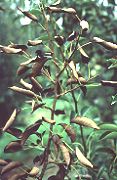
European red miter, Panonychus ulmi (Koch)
and twospotted spider mite, Tetranychus urticae Koch on Pear
I. Introduction: More details are provided in
the Apple section on ERM
and TSM. Details specific to pear are included
here.
II. Injury: These spider mites feed in the same manner as on
apple. However, there is an
important difference in host response. Pear leaves are damaged at lower
mite densities than are apple
leaves. Leaves react to feeding by turning dark brown or black (Plate
92), especially if intense feeding
occurs during a relatively short period. This blackening is related to
reduced water content of
leaves. If growers have not observed this damage previously in their
orchards, fire blight may be
suspected erroneously, but mite foliar injury is more evenly spread
through the canopy, and the typical
crook-necking associated with fire blight is absent. This injury may
result if inappropriate pesticides
are used for summer control of pear psylla.
Oregon researchers have documented reduced fruit set in the following
year, reduced fruit size, and
increased preharvest fruit drop resulting from foliar injury from
spider mites. While early summer
populations may influence fruit size, fruit finish may be affected by
late summer infestations. The
following varieties were ranked from highest to lowest susceptibility:
`Anjou', `Bosc', `Bartlett',
and `Comice'. Australian research has shown that pear trees with leaf
scorch and subsequent defoliation
by TSM have reduced fruit set per cluster, gross fruit yield, and yield
of fruit suitable for canning
in the year following infestation. Trees with 80% leaf scorch and
defoliation experienced yield
reductions of about 2.3 relative to uninfested trees.
III. Monitoring: Follow mite densities during the season by
counting mites per leaf with a
hand lens or leaf-brushing machine. Take 10-40 leaves from the canopies
of 10 trees (use the larger
number in spring, when mites are harder to detect). Calculate the %
infested leaves; from this mites
per leaf can be calculated. This relationship holds until the first
acaricide application.
Although a provisional threshold of 5 mites per leaf has been used in
earlier literature, a more
conservative approach should be used than in apple trees because of
differing host response. Use
an action threshold of 2 mites per leaf (32% of the leaves infested).
If twospotted spider mite is
the primary species present, use 1 per leaf (22% of leaves infested).
Back to Pear
page
Back to Mid-Atlantic
Regional Fruit Loop
